In Texas, Migrants Meet a Land of Walls and Wire
The state has invested billions into deadly barriers at the border, but asylum seekers still come — in higher numbers than ever.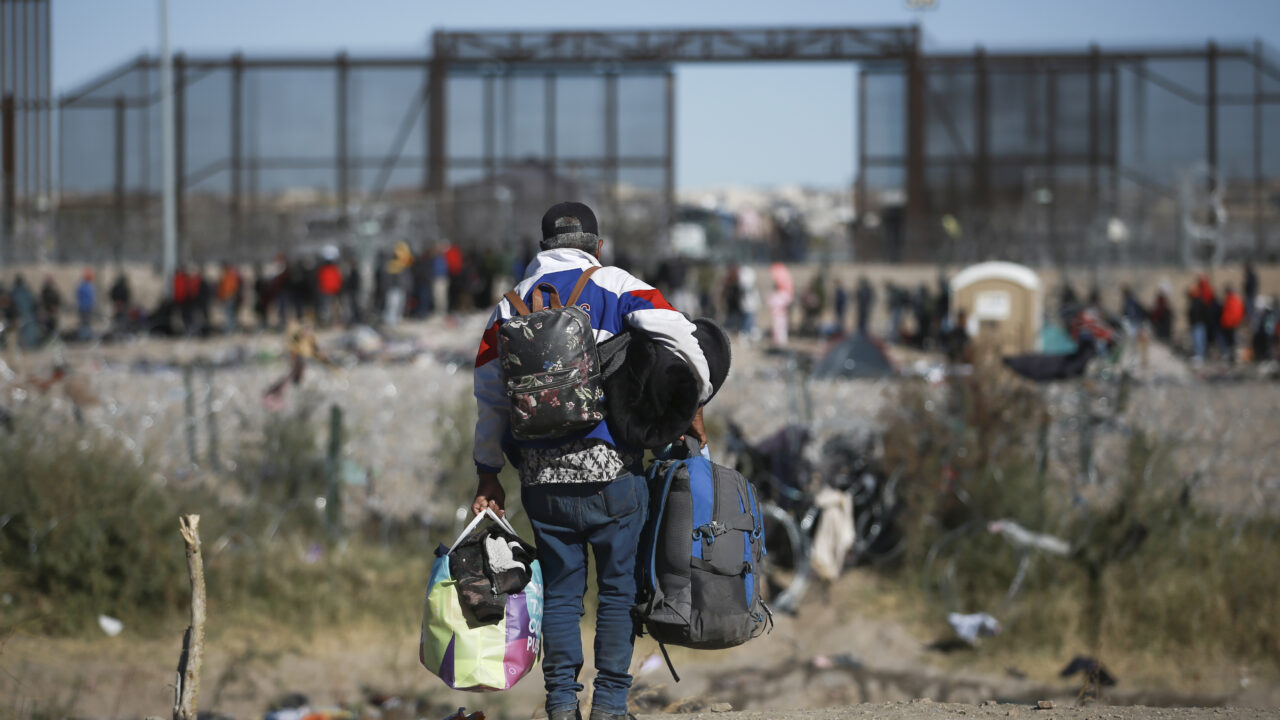 A migrants carries bags towards the U.S. border fence from Ciudad Juarez, Mexico, Wednesday, Dec. 27, 2023. (AP Photo/Christian Chavez)
This is Part I of the "At the Border in 2024" Dig series
A migrants carries bags towards the U.S. border fence from Ciudad Juarez, Mexico, Wednesday, Dec. 27, 2023. (AP Photo/Christian Chavez)
This is Part I of the "At the Border in 2024" Dig series
CIUDAD JUÁREZ, MEXICO — When they find a shallow place to cross the Rio Grande, the two dozen migrants hoist their small children onto their shoulders and wade into the muck. Most wear shoes, because the riverbed is covered in sharp trash. But one agile man goes barefoot and darts back and forth across the river to retrieve children whose mothers prove too unbalanced to trudge through the mud with a top-heavy load. A woman in a pink puffer jacket, now half wet, stumbles and nearly falls in. The center of the river marks the border between Mexico and the United States.
The group hails from Venezuela, Ecuador and Bolivia; all are escaping environments of growing violence, political instability or economic disaster. Several carry letters designating them refugees, signed by officials in countries they passed through during their northward march. Most do not have family already living in the United States and are unsure where they will live or how they will find work in a country where they do not speak the language. Up until this moment, their sole focus has been making it here, to the river, the momentous boundary between known turmoil and imagined calm.
Daniel Lopez, a 12-year-old boy, is the eldest child in the group and the only one able to cross the river on his own. “The entire trip from Venezuela has been easy for me, not for the rest of my family,” he says. His parents and four-year-old sister have experienced the same journey, but struggle with emotional fatigue from the sights of dead bodies in the Darien jungle, the many robberies and the harrowing stories of migrants they met along the way. The family now faces their moment of crescendo, when they will turn themselves in to Border Patrol to begin their asylum screening.
Over the past two years, over 2 million people, most of them from the Americas, have used this process to come to the United States, causing a backlog of up to 10 years in asylum cases.
The right to seek asylum, to ask a country for refuge, is legal under both national and international law. Over the past two years, over 2 million people, most of them from the Americas, have used this process to come to the United States, causing a backlog of up to 10 years in asylum cases. The majority of people fail to prove they are in need of asylum, though some have gained a different legal status after living in the U.S. for years; still others choose to remain despite the issuance of a deportation order. Most people who seek asylum follow the same method the Lopez family is using: crossing the river next to a known “gate” and turning themselves in to Border Patrol.
There’s just one issue with this: Over the past six months, someone else has crashed the party.
Midway through the group’s river passage, Texas National Guard pickup trucks appear on the U.S. bank, and within, armed guardsmen in camouflage uniforms. The appearance of the soldiers is part of Texas Gov. Greg Abbott’s “Operation Lone Star,” a 10 billion dollar set of legal and physical obstacles, ranging from tiny spikes to sweeping legislation, all meant to deter migrants from crossing the Texas border and to muddle the work of federal Border Patrol agents who also operate in the area. These efforts are only intensifying as the 2024 elections loom and anti-migrant rhetoric avalanches Texas.
The National Guard soldiers are separated from the migrants by a web of razor wire they have placed at the riverbank. The migrants must now make it through the hedge of wire and dash a dozen meters to the metal, slatted wall where the Border Patrol awaits — all without the guardsmen catching them. But for now, the soldiers, hands on their hips, blasé in their dominance, are watching the group too closely to allow for an attempt. One of the guardsmen yells out to the group in perfect Spanish, “You can’t cross here, it’s illegal!”
Several of the migrants turn their heads momentarily to the Mexican side of the riverbank, as if contemplating returning, but they’ve come too far; all persist in their shuffle forward. The guardsmen proceed to explain to the group that, should they continue, they’ll have marks on their records. This is a lie. Though crossing the border between ports-of-entry is an “unlawful crossing,” it remains a valid way to access the legal asylum system. The state of Texas does not have enough room in its jails to arrest migrants on misdemeanor trespassing offenses.
“Crossing this way is dangerous, children can get caught in the wire,” a guardswoman yells, as if she had not taken part in installing the wire. Gestating with her pointer finger, she urges the migrants to turn back and make their way to the nearest port-of-entry, a bridge some four miles away. But the migrants know this to be another lie. Friends and relatives have told them that they will be turned away if they try to engage with Border Patrol at the bridge.
When none of their statements seem to have the desired effect, the guardsmen escalate their barrage of false information. They tell the migrants their children will be taken from them by Border Patrol if they persist in crossing over to declare asylum. Now, the group is conflicted. Daniel’s father, Lianka Lopez Flores, 31, is unsure whether to cross the river again and return to Mexico. There is a discussion. Somewhere in the guardsman’s tone, the migrants pick out the lie and guess, correctly, that the Border Patrol has not returned to the tactic of separating nuclear families seeking asylum, as they did during the Trump era.
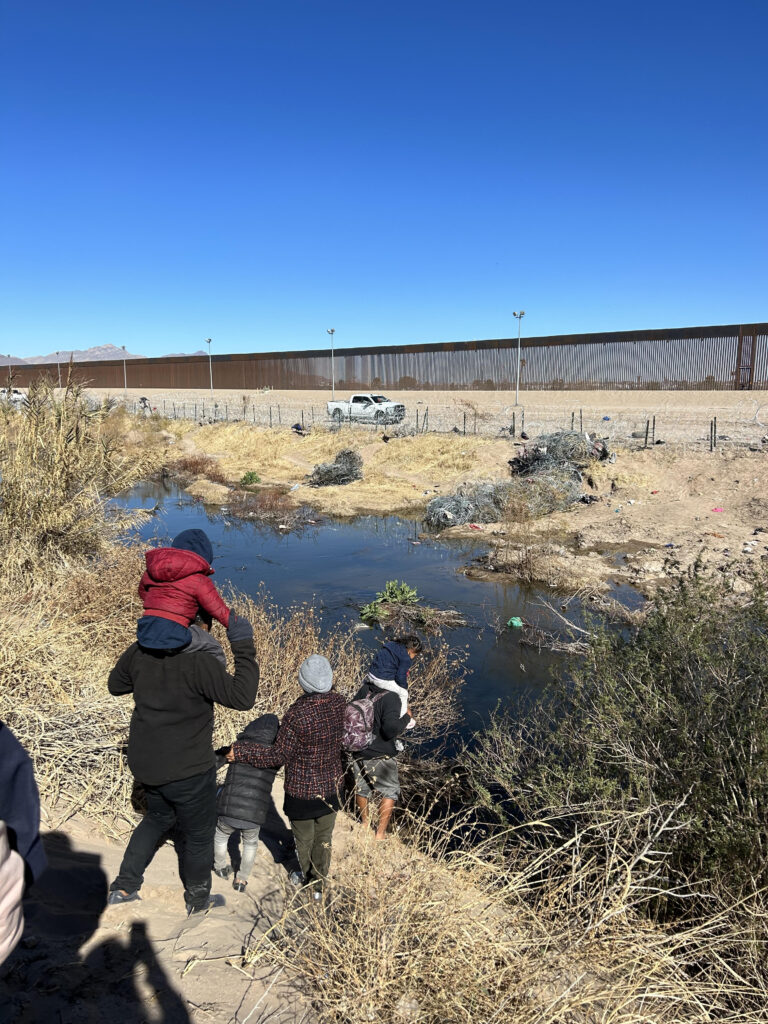
The Lopez family had planned to cross the border a different way. They had made an appointment on the CBP One app, the Border Patrol’s new, if frustrating in its tendency to glitch and stall, method to encourage migrants to enter the asylum process in a more orderly fashion. Over the past year, some 400,000 migrants have used the app to arrange meetings with Border Patrol agents at ports-of-entry, like the aforementioned bridge. But more than 1 million asylum-seekers have chosen to forego the app in the past year and meet the Border Patrol between ports-of-entry at gates like Marker 36, at the border between Ciudad Juárez, Mexico and El Paso, Texas.
In that dust at the riverbank, trodden by so many thousands of feet, migrants must leave behind anything they cannot carry on their backs. In those haunting piles of backpacks and basketball shorts and children’s sandals, one can find many printouts of the CBP One app interface from those who grew weary of waiting for the app to genie them an appointment, confirming a registration that will never be used. Critics of the app are quick to point to its requirement that migrants must have smartphones. When Daniel and his family traveled through Chihuahua for their CBP One appointment, corrupt Mexican immigration officials robbed and physically assaulted the group. Without Lianka’s cell phone, they could no longer attend the appointment.
With his four-year-old daughter strapped to his chest, he uses a discarded blanket to push the wire apart with his bare hands, causing the knifed edges to slice his palms.
Now, the family must cross a barricade of razor wire to reach the gate in the border wall where Border Patrol agents can begin to process their claims. First, they wait for the Texas National Guard pickup truck to drive away. If they attempt to cross the razor wire while guardsmen are watching, the guardsmen will use their bodies, the most intimate and immediate of barriers, to block the path through the thicket of wires. The mostly likely outcome is that the whole group will be forced to turn back.
After about 15 minutes, the Lopez family decides to make a push for the wall. Lianka moves first. With his four-year-old daughter strapped to his chest, he uses a discarded blanket to push the wire apart with his bare hands, causing the knifed edges to slice his palms. He tunnels through the wire, wincing as the blades cut into his back and legs, opening up a larger space for his wife and son to crawl through without injury. When they break free of the wire, they sprint a dozen meters to the wall, Lianka still clutching his daughter to his chest.
When the Texas guardsmen realize the family has escaped the wire, they drive to the spot, bundle all of the blankets and jackets together, and light them on fire, adulterating the beige desert with dense, black smoke. By lessening the supply of cushioning, they ensure the next group of migrants will sustain more serious injuries attempting to cross in that spot.
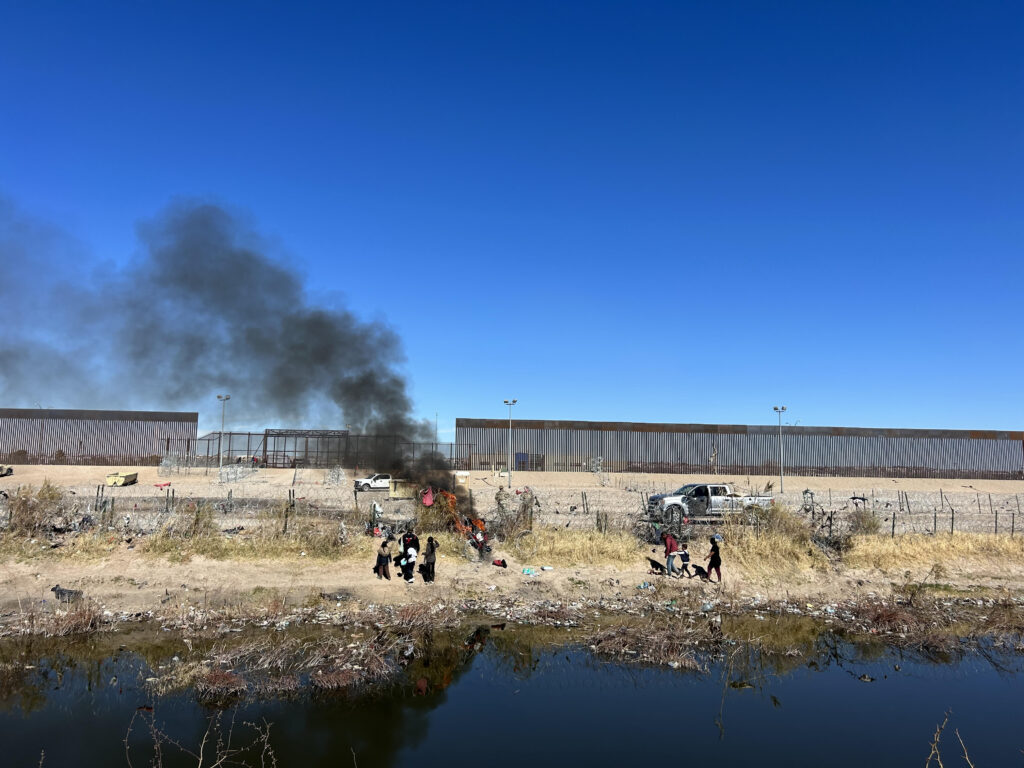
Some 20,000 asylum-seekers from over a dozen countries maneuver their way to the wall and into Border Patrol custody at Marker 36 in any given month. The Lopez family waits at the wall for half an hour before boarding a Border Patrol minivan that takes them to a nearby detention center. Lianka is given medical treatment, his cuts disinfected by on-site nurses — it is an ironic instance of a system inflicting injury, and then stitching up the wounds. “It’s a strong pain,” Lianka tells me. “It cuts you hard.” But it turns out Lianka’s scrapes are comparatively minimal. Glancing around the room, he watches doctors stitch up several people whose legs or arms have “opened completely.”
The razor wire — studded with double-sided, knife-sharp blades, several inches long on both sides — is a relatively new addition to the border landscape in Texas, dating only to last summer. The painful ringlets have failed to deter desperate migrants from crossing the river between points-of-entry — hundreds of thousands of people have crossed the Texas border between ports since July.
The federal government has understood that prevention-through-deterrence doesn’t work for 25 years.
Aaron Reichlin-Melnick, immigration lawyer and policy director at the National Immigration Council, said it is visible to the point of indisputable clarity to anyone on the ground that the physical barriers are not preventing border crossings, just causing injury. “We’ve now seen images and videos for months of migrants clambering through razor wire. And border encounters continue to rise in those very locations,” he said. “So, what is the purpose of all of this?”
Adam Isacson, director of Defense Oversight at the Washington Office on Latin America, believes the razor wire is a political symbol, designed to capture voters’ attention in an election year defined by “tough on migrant” rhetoric. Just last week, a poll showed that, for the first time, a majority of Americans favor a border wall. It is unclear whether those in favor believe the existence of a wall will deter migrants from crossing, or whether the allure of the barrier is symbolic. Various major cities, including El Paso, have had border walls in place since the ’90s, with the intention of forcing migrants to abandon urban environments for daredevil desert crossings where they would be more likely to give up or die from thirst. The tactic led to the development of an extremely lucrative industry of desert guides, smugglers who lead groups of Mexican and Central American migrants safely through treacherous terrain.
Since 2021, Gov. Abbott’s Operation Lone Star has deployed similar strategies of “prevention through deterrence” to make the border physically and legally more difficult to cross. Once again, the strategy has failed, as migrants continue to risk their lives for a chance at a safer and more prosperous existence.
Reichlin-Melnick sees Operation Lone Star as Abbott’s play to create within Texas a “shadow deportation system.” Toward this end, the state is experimenting with tactics long deemed unsuccessful by the Border Patrol. “There is no evidence I’ve seen that Operation Lone Star has had a significant impact on people’s decisions about whether or not to cross the border,” he said.
The federal government has understood that prevention-through-deterrence doesn’t work for 25 years. During the late ’90s, Border Patrol put up, foreboding, iron-red walls in several urban border areas, including El Paso. People just found ways around them. Carlos, a taxi driver in Juárez who did not want to share his last name, has considered crossing the border several times in the past year. “If I wanted to cross, I could do it by myself, just by driving a little further out — everyone living in Juárez knows where the spots are,” he said.
In the winter months, the river itself, on occasion, becomes a covert killing machine. This year, Texas officials are often choosing to forgo rescue operations. Viterma de la Sancha Cerros, from Estado de México, and her two children drowned in January, joining the hundreds of others who have met their end in the river’s silent currents, attempting to cross the border in the past decade. In Cerros’s case, Texas agents did not alert Border Patrol to the incident for hours, far too late to save the family. It is unclear how many people have drowned in the river this year, because neither state nor federal agencies track these deaths.
The limited records we do have document at least 4,000 migrant deaths at the border between 2014 and 2023. Thousands more are missing, according to the United Nations and the Washington Office on Latin America. Most of these people died as a result of barriers imposed by policies of prevention-through-deterrence, their deaths intended as a warning to those who would come after them. And yet, migration rose by over 500% between 2017 and 2023, proving that fears of a grim end are weaker than the conviction among migrants that the United States remains their only viable option for survival.
The limited records we do have document at least 4,000 migrant deaths at the border between 2014 and 2023.
In Lianka’s case, worsening economic conditions in Venezuela had left him making less than $100 a month. His wife, Carolina, closed down her business, a neighborhood daycare, after receiving threats of extortion by a local criminal group. With the family’s entire survival on Lianka’s shoulders, he began making plans for the long trip north, come hell or high water. “I wasn’t making enough for us to eat,” he said. If the asylum system did not exist, the family would have found another way.
Prevention-through-deterrence guarantees income for smugglers, as they will always find a way to get across. Revoking the right to seek asylum would only balloon the smuggling industry further, as their customer base would represent the entire world, not just Central America and Mexico. With their services in greater demand, smugglers would increase their prices, which currently range between three and 10 thousand dollars per person. Juarez whispers with rumors that this is already happening as the Texas government ramps up the introduction of new physical and legal obstacles at the border.
This year’s political and legal disagreements between Austin and Washington D.C. have complicated an already labyrinthine landscape for migrants seeking to cross the border. Whether they arrive seeking asylum or not, they confront two systems in conflict. As Reichlin-Melnick points out, the murky situation is catnip for smugglers who can stand apart within the confusion: Every time a new law comes into effect at the border, or another physical obstacle is added to the terrain, smugglers use the fear and confusion to pry ever larger sums of money from migrants. (In the past year, while trying to enforce Operation Lone Star, Texas National Guard soldiers have caused 74 fatal car crashes, killing migrants, U.S. civilians and guardsmen attempting to catch smugglers.)
In an El Paso shelter, Lianka’s skin knits itself back together, until all that remains of his injuries are faint threads of red across his palms and back. For several days, the family withers in a state of emotional paralysis, impotent when it comes to the decision before them: Should they stay in Texas, or travel elsewhere?
Every day, down at the Rio Grande, lines of migrants battle lines of wire, and they always win, their skin betraying their effort. At the northern end of the Darien Gap, the jungle pass separating Colombia and Panama, over a thousand migrants emerge every day. In two weeks, they’ll be at the border, ready for their turn against their silver opponent, foraging for blankets to soften the way.
Your support matters…Independent journalism is under threat and overshadowed by heavily funded mainstream media.
You can help level the playing field. Become a member.
Your tax-deductible contribution keeps us digging beneath the headlines to give you thought-provoking, investigative reporting and analysis that unearths what's really happening- without compromise.
Give today to support our courageous, independent journalists.


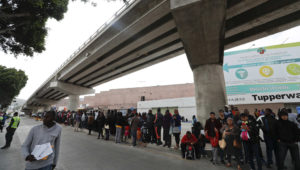

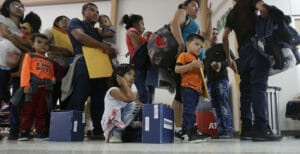

You need to be a supporter to comment.
There are currently no responses to this article.
Be the first to respond.